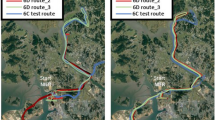Abstract
The aim of this study was to develop a model structure and to train a model based on chassis dynamometer datasets and subsequently use the trained model in conjunction with portable emission measurement system (PEMS) datasets in order to identify vehicles as possible high-NOx emitters. The long-short term memory (LSTM) model developed based on a single reference diesel vehicle dataset was applied to 12 diesel vehicle PEMS datasets in order to identify high-NOx emitters. The results showed that the vehicles that were manually identified as high emitting vehicles (i.e., control subjects) were also identified by the LSTM model to exceed real-world NOx emissions. Similarly, a random forest (RF) model was developed for a reference CNG vehicle and subsequently applied to 11 CNG vehicles, with a 0.2-g/bhp-hr NOx regulation limit, using PEMS data in order to identify any possible high NOx emitting vehicles. The results showed that the vehicles that were manually labeled as high emitters were also identified by the RF model to exhibit high real-world NOx emissions. The prediction results show that high NOx emitting vehicles had ratios of predicted versus measured NOx emissions that were lower than unity.












Similar content being viewed by others
References
Kasab, J., Strzelec, A.: Automotive Emissions Regulations and Exhaust Aftertreatment Systems. SAE Int. (2020). https://doi.org/10.4271/9780768099560
Badshah, H., Posada F.: Current state of NOx emissions from in-use heavy-duty diesel vehicles in the United States, 2019. [Online]. Available: http://www.theicct.orgcommunications@theicct.org. Accessed 9 Sept 2022
Huang, Y., Lee, C., Yam, Y.S., Mok, W.-C., Zhou, J., Zhuang, Y., Surawski, N., Organ, B., Chan, E.: Rapid detection of high-emitting vehicles by on-road remote sensing technology improves urban air quality. Sci. Adv. 8, eabl7575 (2022). https://doi.org/10.1126/sciadv.abl7575
Tu, J., Wayne, W., Perhinschi, Mario.: Correlation Analysis of Duty Cycle Effects on Exhaust Emissions and Fuel Economy. Journal of the Transportation Research Forum (2013).https://doi.org/10.5399/osu/jtrf.52.1.4136
Heywood, J.B.: Internal Combustion Engine Fundamentals. New York: McGraw-Hill, 1988
Chen, H.Y., Chang, H.L.R.: Development of low temperature three-way catalysts for future fuel-efficient vehicles, Johnson Matthey Technology Review, vol. 59, no. 1. Johnson Matthey Public Limited Company, pp. 64–67 (2015). https://doi.org/10.1595/205651315X686011
Quiros, D.C., et al.: Real-world emissions from modern heavy-duty diesel, natural gas, and hybrid diesel trucks operating along major California freight corridors. Emiss. Control Sci. Technol. 2(3), 156–172 (2016). https://doi.org/10.1007/s40825-016-0044-0
Woodburn, J., Merkisz, J., Bielaczyc, P.: The formation of ammonia in three-way catalysts fitted to spark ignition engines -mechanisms and magnitudes (2022).https://doi.org/10.4271/2022-01-1026
Tan, Y., et al.: Assessment of in-use NOx emissions from heavy-duty diesel vehicles equipped with selective catalytic reduction systems. Environ. Sci. Technol. 55(20), 13657–13665 (2021). https://doi.org/10.1021/acs.est.1c03042
Zhang, A., Ballas, N., Pineau, J.: A dissection of overfitting and generalization in continuous reinforcement learning, ArXiv, vol. abs/1806.07937, 2018, [Online]. Available: https://api.semanticscholar.org/CorpusID:49351001. Accessed 24 Sept 2023
Katreddi, S., Thiruvengadam, A.: Trip based modeling of fuel consumption in modern heavy-duty vehicles using artificial intelligence. Energies (Basel), 14(24), (2021). https://doi.org/10.3390/en14248592
Qiao, F., Nabi, M., Li, Q., Yu, L.: A machine learning approach for light-duty vehicle idling emission estimation based on real driving and environmental information. Transp. Res. Rec. 2674(8), 37–52 (2020). https://doi.org/10.1177/0361198120922997
Galonja, G.: Improving vehicle diagnostic solutions for heavy-duty vehicles through machine learning. A study on preventive fault detection in fuel injectors through the use of warranty claim data, operational data and fault codes (2020). [Online]. Available: http://www.chalmers.se. Accessed 16 Sept 2023
Wu, X., et al.: High-resolution mapping of regional traffic emissions using land-use machine learning models. Atmos. Chem. Phys. 22(3), 1939–1950 (2022). https://doi.org/10.5194/acp-22-1939-2022
Qiu, M., Borken-Kleefeld, J.: Using snapshot measurements to identify high-emitting vehicles. Environ. Res. Lett. 17(4) (2022). https://doi.org/10.1088/1748-9326/ac5c9e
Qiao, F., Nabi, M., Li, Q., Yu, L.: Estimating light-duty vehicle emission factors using random forest regression model with pavement roughness. Transp. Res. Rec. 2674(8), 37–52 (2020). https://doi.org/10.1177/0361198120922997
Cornec, C.M.A., Molden, N., van Reeuwijk, M., Stettler, M.E.J.: Modelling of instantaneous emissions from diesel vehicles with a special focus on NOx: Insights from machine learning techniques. Sci. Total Environ. 737, (2020). https://doi.org/10.1016/j.scitotenv.2020.139625
Traver, M.L., Atkinson, R.J., Atkinson, C.M.: Neural network-based diesel engine emissions prediction using in-cylinder combustion pressure (1999). [Online]. Available: https://www.jstor.org/stable/44716748. Accessed 16 Sept 2022
Barth, M., Scora, G., Younglove, T.: Modal emissions model for heavy-duty diesel vehicles (2004)
Pillai, R. et al.: Modeling and predicting heavy-duty vehicle engine-out and tailpipe nitrogen oxide (NOx) emissions using deep learning. Front. Mech. Eng. 8, (2022). https://doi.org/10.3389/fmech.2022.840310
Leonard, J. et al.: In-use emissions testing and activity profiles for on-road heavy-duty vehicles (2023). [Online]. Available: http://www.cert.ucr.edu/emissions-and-fuelswww.cafee.wvu.edu/. Accessed 10 Sept 2023
Bonaccorso, G.: Machine learning algorithms. 2nd ed. Packt Publishing. (2018). https://www.perlego.com/book/799726/machine-learning-algorithms-popular-algorithms-for-data-science-and-machine-learning-2nd-edition-pdf
Krijnsen, H.C., Wijnand E. J. van Kooten, H.P.A. Calis, Ruud P. Verbeek, and Cor M. van den Bleek.: Prediction of NOx Emissions from a Transiently Operating Diesel Engine Using an Artificial Neural Network. Chem. Eng. Technol. (1999). https://doi.org/10.1002/(sici)1521-4125(199907)22:73.0.co;2-t
Yu, Y., Wang, Y., Li, J., Fu, M., Shah, A.N., He, C.: A novel deep learning approach to predict the instantaneous NOx emissions from diesel engine. IEEE Access 9, 11002–11013 (2021). https://doi.org/10.1109/ACCESS.2021.3050165
Maniatopoulos, A., Mitianoudis, N.: Learnable Leaky ReLU (LeLeLU): an alternative accuracy-optimized activation function. Information (Switzerland) 12(12), (2021). https://doi.org/10.3390/info12120513
Author information
Authors and Affiliations
Contributions
Filiz Kazan: formal analysis, validation, investigation, writing — original draft.
Arvind Thiruvengadam: writing — review and editing, supervision, visualization, project administration.
Marc Besch: resources, data curation, supervision.
Corresponding author
Ethics declarations
Competing Interests
The authors declare that they have no competing interests.
Additional information
Publisher's Note
Springer Nature remains neutral with regard to jurisdictional claims in published maps and institutional affiliations.
Rights and permissions
Springer Nature or its licensor (e.g. a society or other partner) holds exclusive rights to this article under a publishing agreement with the author(s) or other rightsholder(s); author self-archiving of the accepted manuscript version of this article is solely governed by the terms of such publishing agreement and applicable law.
About this article
Cite this article
Kazan, F., Thiruvengadam, A. & Besch, M.C. Assessment of On-Road High NOx Emitters by Using Machine Learning Algorithms for Heavy-Duty Vehicles. Emiss. Control Sci. Technol. 9, 177–188 (2023). https://doi.org/10.1007/s40825-023-00232-1
Received:
Revised:
Accepted:
Published:
Issue Date:
DOI: https://doi.org/10.1007/s40825-023-00232-1




